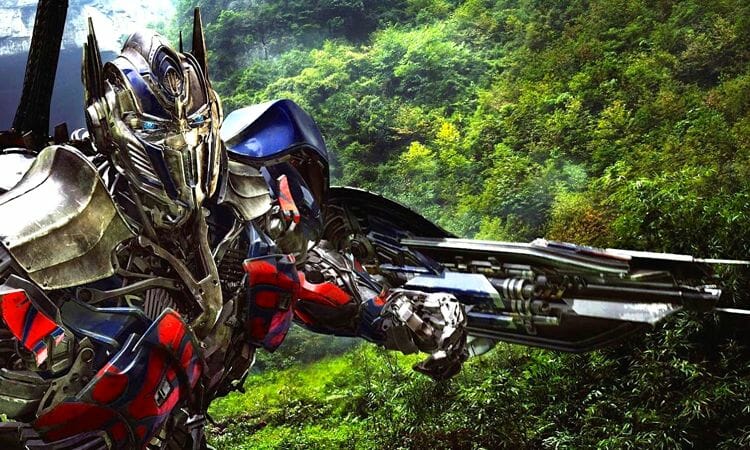By Alec Siegel · June 30, 2014

An Oreo cookie shipping truck that doubles as a shape-shifting robot. A Beats by Dr. Dre Pill speaker system. Dodges, Bugattis, Chevrolets, Jeeps and Lamborghinis that, yep, also double as shape-shifting robots. No, I have not just rattled off an early preview of the products to be shown during the Super Bowl XLVII commercials. These are just props from Michael Bay’s latest installment in his Hasbro toy-based Transformers franchise. Franchise is the key word here. What these films have become, as have most over bloated, Hollywood serials, are product placement orgasms, light in plot and character and wit, but loaded with corporate slights of hand and loud action sequences. And usually a pretty face or three.
The fourth film in the series, Transformers: Age of Extinction has a basic premise hidden beneath confusing mythology and metallic trash. The film picks up where the last one left off: The American government has decided to do away with all alien cyborgs, Autobots and Decepticons alike. The Autobots just want to go home, and the ever-swaggering Decepticons lurk in the shadows and wait for the return of their leader, Megatron. A new angle of corporate greed is thrown in for good measure, and actually gives the stale good bot vs bad bot Transformers plotline a bit of fresh air. However simple that sounds, it plays out clumsily, and its easy to get lost in the ambiguous “Seed” references and litany of characters, both human and robot. Sci-fi action films often try to find an awkward balance between intriguing mythology, engaging action and humor. Age of Extinction goes 0 for 3 on that account, though it’s unintentionally hilarious with its outrageously bad one-liners and clichéd self-talk. Yes, the characters often talk to themselves.
Read More: Best Movies Based on Real-Life Toys
Michael Bay, at the helm as director here as he was for the first three Transformer films, does what he does best: action sequences. A quiet, humble Texas barn house is obliterated by missiles and flames. Optimus Prime, head of the Autobots (the charismatic good bots featuring characters voiced by John Goodman and Ken Watanabe), somersaults slow motion through the air for what seems like half of the film. Enormous Transformer ships descend from the sky like slow moving black comets come to wreck havoc on helpless humans. Bay has an impressive eye for angles and effects when it comes to action, but at some point, pretty early on actually, it starts to wear. The characters are one dimensional and at times unbelievable (in the literal sense of the word). Joshua Joyce (Stanley Tucci), is a cunning corporate blood sucker for the first two thirds of the film, then is suddenly a shouting bafoon who just wants a happy ending towards the conclusion. Mark Wahlberg is serviceable as Cade Yaeger, a classic failed inventor who has a child’s imagination but also sense of responsibility, but most of his time on screen is for him to flex his bulging arms, not his acting chops. It seems like the bigger a film’s budget, the bigger Marky Mark’s triceps get.
The fist Transformers in 2007 was fun with its fresh concept, coherent plot, likeable characters, and Megan Fox on a motorcycle. Since then, each film in this series has taken a dip in quality, and Age of Extinction is the poorest. The film is a cash cow, as most everything in it seems engineered to attract a different corner of the vast, international film demographic landscape. Nicola Peltz as Tessa Yaeger, Cade’s daughter, and Li Bingbing as the Chinese head of a KSI outlet based in Beijing, are both comely actresses that are sure to appeal to hormone fueled teenage boys. Wahlberg and Jack Reynor, a young Irish actor who plays Shane, Tessa’s racecar driving boyfriend, will bring in the females. Portions of the film take place in Hong Kong, which makes sense, because China is a large film market with filmgoers eager to get a taste of explosive Hollywood cinema. The only demographic that seems to have been left out are those who go to the movies to see magic, to feel emotion (besides impatience and frustration) and to look at extensions of themselves in the silver screen mirror. I could be wrong. This film might have been made as a serious attempt at art, or at the very least, entertainment. But if that’s the case, it’s failed miserably. However, as it goes in most big budget films, Bay and his cohorts will most likely only need to point at the box office numbers to tell me they’ve succeeded.